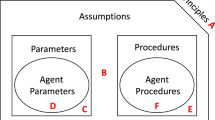Abstract
Multi-Agent Systems (MAS) have great potential for explaining interactions among heterogeneous actors in complex environments: the primary task of social science. I shall argue that one factor hindering realisation of this potential is the neglect of systematic data use and appropriate data collection techniques. The discussion will centre on a concrete example: the properties of MAS to model innovation diffusion.
Access this chapter
Tax calculation will be finalised at checkout
Purchases are for personal use only
Preview
Unable to display preview. Download preview PDF.
Similar content being viewed by others
References
Bousquet, F. et al. Simulating Fishermen’s Society, In: Gilbert, N. and Doran, J. E. (Eds.) Simulating Societies London: UCL Press, 1994.
Chamberlayne, P., Bornat, J. and Wengraf, T. (eds.) The Turn to Biographical Methods in the Social Sciences: Comparative Issues and Examples London: Routledge, 2000.
Chattoe, E. Why Is Building Multi-Agent Models of Social Systems So Difficult? A Case Study of Innovation Diffusion, XXIV International Conference of Agricultural Economists IAAE, Mini-Symposium on Integrating Approaches for Natural Resource Management and Policy Analysis, Berlin, 13–19 August, 2000.
Chattoe, E. and Heath, A. A New Approach to Social Mobility Models: Simulation as “Reverse Engineering” Presented at the BSA Conference, Manchester Metropolitan University, 9–12 April, 2001.
Chattoe, E. and Gilbert, N. A Simulation of Adaptation Mechanisms in Budgetary Decision Making, in Conte, R. et al. (Eds.) Simulating Social Phenomena Berlin: SpringerVerlag, 1997.
Davis, J. A. What’s Wrong with Sociology? Sociological Forum, 9:179–197, 1994.
De Vaus, D. A. Surveys in Social Research, 3rd ed. London: UCL Press, 1991.
Doran J. E. From Computer Simulation to Artificial Societies, Transactions of the Society for Computer Simulation, 14:69–77, 1997.
Doran, J. E. Simulating Collective Misbelief Journal of Artificial Societies and Social Simulation, 1(1), <http://www.soc.surrey.ac.uk/JASSS/1/1/3.html>, 1998.
Finch, J. The Vignette Technique in Survey Research, Sociology, 21:105–114, 1987.
Gilbert, N. Emergence in Social Simulation, In Gilbert, N. and Conte, R. (eds.) Artificial Societies. London: UCL Press, 1995.
Gladwin, C. H. Ethnographic Decision Tree Modelling, Sage University Paper Series on Qualitative Research Methods Vol. 19 London: Sage Publications, 1989.
Hedström, P. and Swedberg, R. Social Mechanisms: An Analytical Approach to Social Theory Cambridge: CUP, 1998.
Hey, J. D. Experiments in Economics Oxford: Basil Blackwell, 1991.
Kirchler, E. Studying Economic Decisions Within Private Households: A Critical Review and Design for a “Couple Experiences Diary”, Journal of Economic Psychology, 16:393–419, 1995.
Moss, S. Critical Incident Management: An Empirically Derived Computational Model, Journal of Artificial Societies and Social Simulation, 1(4), <http://www.soc.surrey.ac.uk/JASSS/1/4/1.html>, 1998.
Ranyard, R. and Craig, G. Evaluating and Budgeting with Instalment Credit: An Interview Study, Journal of Economic Psychology, 16:449–467, 1995.
Rogers, E. M. Diffusion of Innovations, 4th ed. New York: The Free Press, 1995.
Wilkinson, S. Focus Group Methodology: A Review, International Journal of Social Research Methodology, 1:181–203, 1998.
Wood, L. A. and Kroger, R. O. Doing Discourse Analysis: Methods for Studying Action in Talk and Text London: Sage Publications, 2000.
Wooffitt, R. and Hutchby, I. Conversation Analysis Cambridge: Polity Press, 1998.
Author information
Authors and Affiliations
Editor information
Editors and Affiliations
Rights and permissions
Copyright information
© 2002 Kluwer Academic Publishers
About this chapter
Cite this chapter
Chattoe, E. (2002). Building Empirically Plausible Multi-Agent Systems. In: Dautenhahn, K., Bond, A., Cañamero, L., Edmonds, B. (eds) Socially Intelligent Agents. Multiagent Systems, Artificial Societies, and Simulated Organizations, vol 3. Springer, Boston, MA. https://doi.org/10.1007/0-306-47373-9_13
Download citation
DOI: https://doi.org/10.1007/0-306-47373-9_13
Publisher Name: Springer, Boston, MA
Print ISBN: 978-1-4020-7057-0
Online ISBN: 978-0-306-47373-9
eBook Packages: Springer Book Archive




